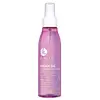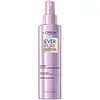What's inside
What's inside
 Key Ingredients
Key Ingredients

 Benefits
Benefits

 Concerns
Concerns

 Ingredients Side-by-side
Ingredients Side-by-side

Water
Skin ConditioningPropylene Glycol
HumectantPEG-12 Dimethicone
Skin ConditioningGlycerin
HumectantPEG-40 Hydrogenated Castor Oil
EmulsifyingPhenoxyethanol
PreservativeParfum
MaskingDisodium EDTA
DMDM Hydantoin
PreservativeTrideceth-5
EmulsifyingArgania Spinosa Kernel Oil
EmollientHelianthus Annuus Seed Oil
EmollientTocopheryl Acetate
AntioxidantCocodimonium Hydroxypropyl Hydrolyzed Keratin
Skin ConditioningHydrolyzed Wheat Protein
Skin ConditioningHydrolyzed Corn Protein
Skin ConditioningHydrolyzed Soy Protein
HumectantAmodimethicone
Ethylhexyl Salicylate
UV AbsorberWater, Propylene Glycol, PEG-12 Dimethicone, Glycerin, PEG-40 Hydrogenated Castor Oil, Phenoxyethanol, Parfum, Disodium EDTA, DMDM Hydantoin, Trideceth-5, Argania Spinosa Kernel Oil, Helianthus Annuus Seed Oil, Tocopheryl Acetate, Cocodimonium Hydroxypropyl Hydrolyzed Keratin, Hydrolyzed Wheat Protein, Hydrolyzed Corn Protein, Hydrolyzed Soy Protein, Amodimethicone, Ethylhexyl Salicylate
Water
Skin ConditioningCocos Nucifera Oil
MaskingAmodimethicone
PPG-5-Ceteth-10 Phosphate
EmulsifyingPolyquaternium-37
Phenoxyethanol
PreservativeParfum
MaskingPropylene Glycol Dicaprylate/Dicaprate
EmollientSodium Hydroxide
BufferingDimethicone
EmollientBehentrimonium Chloride
PreservativePPG-1 Trideceth-6
Skin ConditioningTrideceth-6
EmulsifyingEthylhexyl Salicylate
UV AbsorberEthylhexylglycerin
Skin ConditioningPropylene Glycol
HumectantIsopropyl Alcohol
SolventSorbitan Oleate
EmulsifyingDimethiconol
EmollientLimonene
PerfumingCetrimonium Chloride
AntimicrobialLinalool
PerfumingHydroxycitronellal
PerfumingCitronellol
PerfumingCoumarin
PerfumingRosa Centifolia Extract
Skin ConditioningGeraniol
PerfumingPrunus Amygdalus Dulcis Seed Extract
Skin ConditioningTocopherol
AntioxidantXanthan Gum
EmulsifyingDehydroacetic Acid
PreservativeWater, Cocos Nucifera Oil, Amodimethicone, PPG-5-Ceteth-10 Phosphate, Polyquaternium-37, Phenoxyethanol, Parfum, Propylene Glycol Dicaprylate/Dicaprate, Sodium Hydroxide, Dimethicone, Behentrimonium Chloride, PPG-1 Trideceth-6, Trideceth-6, Ethylhexyl Salicylate, Ethylhexylglycerin, Propylene Glycol, Isopropyl Alcohol, Sorbitan Oleate, Dimethiconol, Limonene, Cetrimonium Chloride, Linalool, Hydroxycitronellal, Citronellol, Coumarin, Rosa Centifolia Extract, Geraniol, Prunus Amygdalus Dulcis Seed Extract, Tocopherol, Xanthan Gum, Dehydroacetic Acid
Ingredients Explained
These ingredients are found in both products.
Ingredients higher up in an ingredient list are typically present in a larger amount.
This water-soluble silicone is used for its hydrating and softening properties. It is used to add a silky feel to skincare products and has great benefits for haircare.
In haircare, this ingredient:
- Adds shine
- Protects color
- Offers thermal protection
- Boosts hair strength
- Does not build up as easily
Ethylhexyl Salicylate is an organic compound used to block UV rays. It primarily absorbs UVB rays but offers a small amount of UVA protection as well.
Commonly found in sunscreens, Ethylhexyl Salicylate is created from salicylic acid and 2-ethylhexanol. You might know salicylic acid as the effective acne fighter ingredient and BHA.
The ethylhexanol in this ingredient is a fatty alcohol and helps hydrate your skin, similar to oils. It is an emollient, which means it traps moisture into the skin.
According to manufacturers, Ethylhexyl Salicylate absorbs UV wavelength of 295-315 nm, with a peak absorption at 307-310 nm. UVA rays are linked to long term skin damage, such as hyperpigmentation. UVB rays emit more energy and are capable of damaging our DNA. UVB rays cause sunburn.
Learn more about Ethylhexyl SalicylateParfum is a catch-all term for an ingredient or more that is used to give a scent to products.
Also called "fragrance", this ingredient can be a blend of hundreds of chemicals or plant oils. This means every product with "fragrance" or "parfum" in the ingredients list is a different mixture.
For instance, Habanolide is a proprietary trade name for a specific aroma chemical. When used as a fragrance ingredient in cosmetics, most aroma chemicals fall under the broad labeling category of “FRAGRANCE” or “PARFUM” according to EU and US regulations.
The term 'parfum' or 'fragrance' is not regulated in many countries. In many cases, it is up to the brand to define this term.
For instance, many brands choose to label themselves as "fragrance-free" because they are not using synthetic fragrances. However, their products may still contain ingredients such as essential oils that are considered a fragrance by INCI standards.
One example is Calendula flower extract. Calendula is an essential oil that still imparts a scent or 'fragrance'.
Depending on the blend, the ingredients in the mixture can cause allergies and sensitivities on the skin. Some ingredients that are known EU allergens include linalool and citronellol.
Parfum can also be used to mask or cover an unpleasant scent.
The bottom line is: not all fragrances/parfum/ingredients are created equally. If you are worried about fragrances, we recommend taking a closer look at an ingredient. And of course, we always recommend speaking with a professional.
Learn more about ParfumPhenoxyethanol is a preservative that has germicide, antimicrobial, and aromatic properties. Studies show that phenoxyethanol can prevent microbial growth. By itself, it has a scent that is similar to that of a rose.
It's often used in formulations along with Caprylyl Glycol to preserve the shelf life of products.
Propylene Glycol is an odorless, colorless liquid. As a humectant, it helps skin retain moisture. It also aids in delivering active ingredients.
Another role of this ingredient is preventing a product from melting or freezing. Propylene glycol also adds antimicrobrial properties to a product, elongating product lifespan.
This ingredient is considered an organic alcohol and commonly added into both cosmetics and foods.
Those with sensitive skin or conditions may develop a rash when using this ingredient.
Learn more about Propylene GlycolWater. It's the most common cosmetic ingredient of all. You'll usually see it at the top of ingredient lists, meaning that it makes up the largest part of the product.
So why is it so popular? Water most often acts as a solvent - this means that it helps dissolve other ingredients into the formulation.
You'll also recognize water as that liquid we all need to stay alive. If you see this, drink a glass of water. Stay hydrated!
Learn more about Water